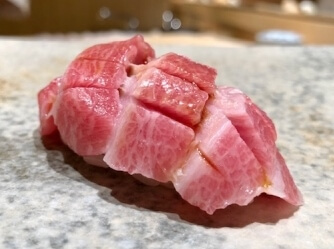 A single bite of the same bluefin tuna differs greatly depending on the part of the fish it came from.
A single bite of the same bluefin tuna differs greatly depending on the part of the fish it came from.
The body of the fish is broadly categorized into the dorsal (back) and the ventral (belly) sides, which taste completely different. Of course the meat near the head tastes completely different from the meat near the tail. If you dig even deeper, there are parts that aren’t as well-known as the Otoro (fatty), Chutoro (medium fatty) and Akami (lean) tuna meats. We’d like to explain those now.
1. Hachinomi or Tsunotoro Nouten
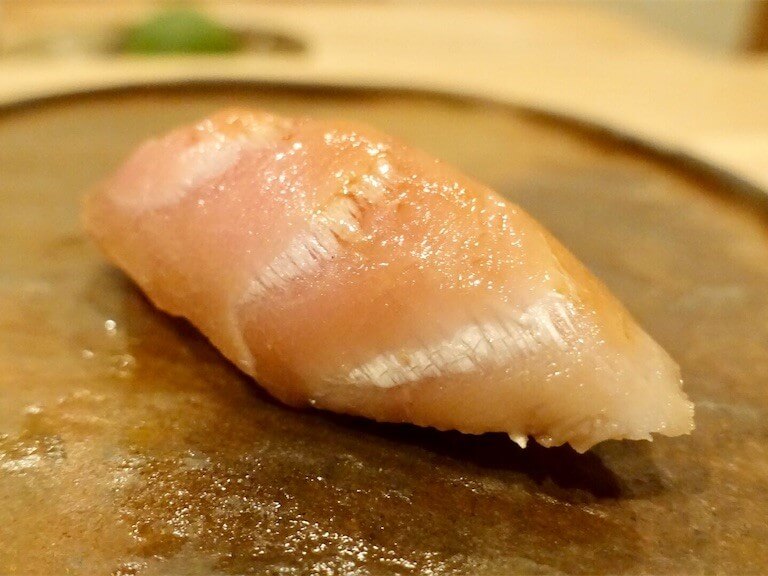 “Hachinomi (ハチの身) or Tsunotoro Nouten” is the meat from the crown of the head. It is fatty and rich and also called “Head Toro”. Only about 1kg of this precious meat can be taken from even a very large fish, and it is only shared with regular, loyal customers.
“Hachinomi (ハチの身) or Tsunotoro Nouten” is the meat from the crown of the head. It is fatty and rich and also called “Head Toro”. Only about 1kg of this precious meat can be taken from even a very large fish, and it is only shared with regular, loyal customers.
2. Kamatoro
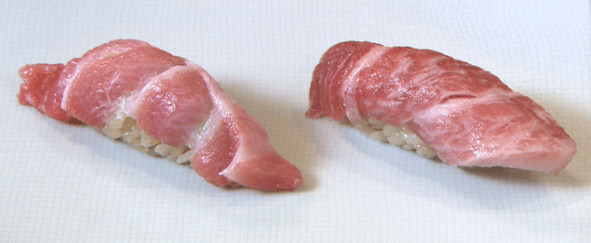 “Kamatoro (カマトロ)” is taken from behind the jaw. It is known as “shimofuri (霜降り)” or marbled meat. There are no veins in this part so the meat is soft and the marbling is more detailed than Otoro, so it is sticky and melts in your mouth. The balance of fat and sweetness in this part is unparalleled. It can be said that otoro (such as shimofuri and jabara) of tuna is the representative part of toro tuna. This is an image of the shimofuri on the right, and the jabara (蛇腹) on the left.
“Kamatoro (カマトロ)” is taken from behind the jaw. It is known as “shimofuri (霜降り)” or marbled meat. There are no veins in this part so the meat is soft and the marbling is more detailed than Otoro, so it is sticky and melts in your mouth. The balance of fat and sweetness in this part is unparalleled. It can be said that otoro (such as shimofuri and jabara) of tuna is the representative part of toro tuna. This is an image of the shimofuri on the right, and the jabara (蛇腹) on the left.
3. Chiai
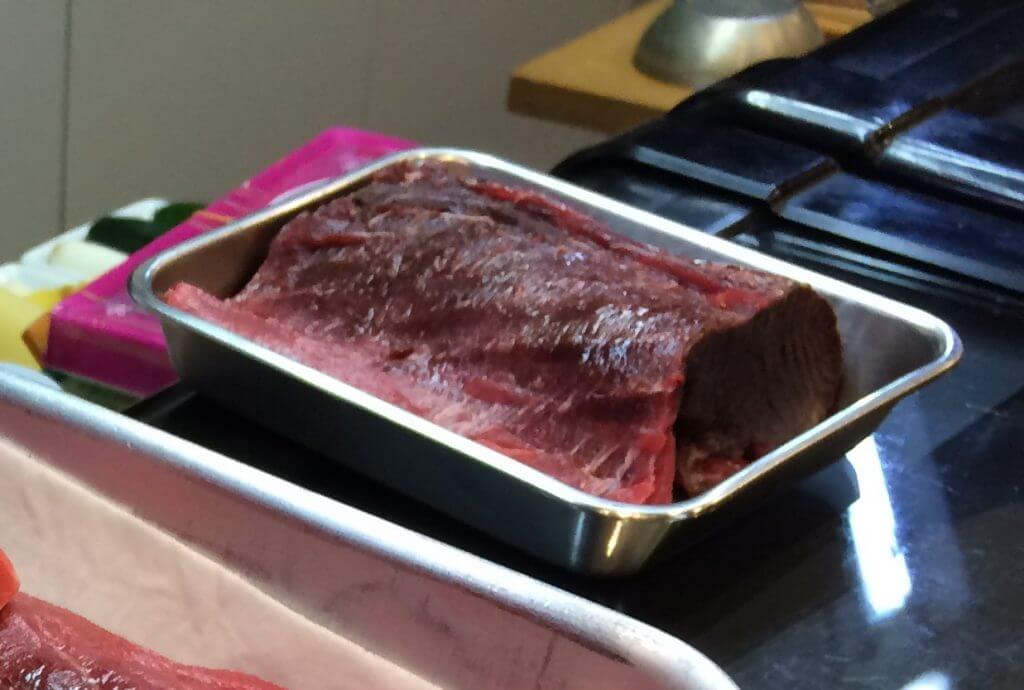 “Chiai (血合い)” is the part with the most veins, so it is a dark red color. It has a strong odor of blood and has multiple times the acidity of the lean meat, so it is not used as a sushi topping. Chiai is rich in iron and protein and is considered to be highly nutritious. Recently, it has been discovered that selenonine, an antioxidant found in high concentrations in tuna and mackerel, is effective in preventing lifestyle-related diseases, reducing stress, and promoting anti-aging.
“Chiai (血合い)” is the part with the most veins, so it is a dark red color. It has a strong odor of blood and has multiple times the acidity of the lean meat, so it is not used as a sushi topping. Chiai is rich in iron and protein and is considered to be highly nutritious. Recently, it has been discovered that selenonine, an antioxidant found in high concentrations in tuna and mackerel, is effective in preventing lifestyle-related diseases, reducing stress, and promoting anti-aging.
4. Chiai Gishi
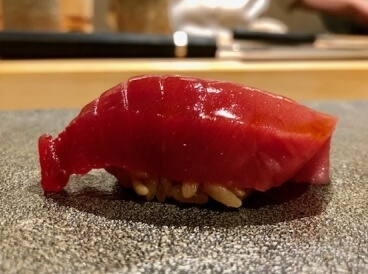 “Chiai Gishi (血合いぎし)” -Located right next to chiai, this is the meat you can taste the umami of the rich red meat and the sweetness of toro fat at the same time.
“Chiai Gishi (血合いぎし)” -Located right next to chiai, this is the meat you can taste the umami of the rich red meat and the sweetness of toro fat at the same time.
5. Wakaremi
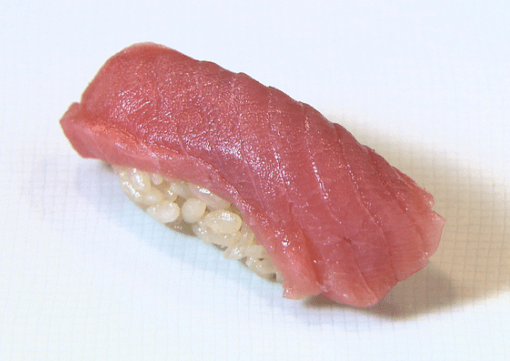
“Wakaremi (分かれ身)” is a precious part with very little meat found next to the dorsal fin. The part especially close to the dorsal fin is popular and called “Setoro (背トロ)”. Setoro has both the umami of akami and the umami of fat. The fat isn’t overbearing so you can eat a ton. However, this part is hard to get, even in high-quality tuna and is not available except to regular customers in almost all sushi restaurants.
6. Tossaki
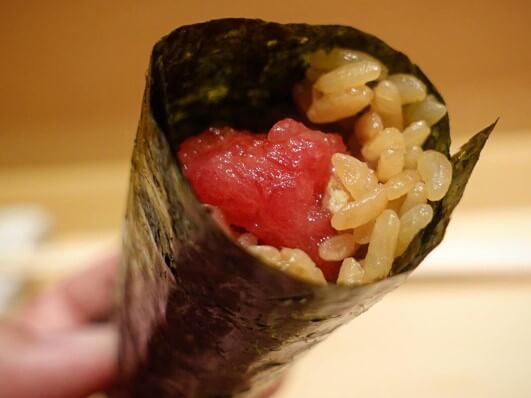 A sushi chef, Hiroyuki Sato, serves a tossaki hand roll as the first sushi piece of the course. “Tossaki (突先)” is an exclusive cut of tuna that goes well with sushi rice using red vinegar, which is less sour but has more umami and flavor compared with white vinegar. Because tossaki is the base of the tuna’s head and it moves a lot, there are a lot of muscular striations. Therefore it needs to be prepared using the back of a knife carefully as if peeling it off (Hagashi). It is said that tossaki is a high-tuna-flavor cut. A couple of Sato’s apprentices also offer a hand roll to open up the meal in the same way.
A sushi chef, Hiroyuki Sato, serves a tossaki hand roll as the first sushi piece of the course. “Tossaki (突先)” is an exclusive cut of tuna that goes well with sushi rice using red vinegar, which is less sour but has more umami and flavor compared with white vinegar. Because tossaki is the base of the tuna’s head and it moves a lot, there are a lot of muscular striations. Therefore it needs to be prepared using the back of a knife carefully as if peeling it off (Hagashi). It is said that tossaki is a high-tuna-flavor cut. A couple of Sato’s apprentices also offer a hand roll to open up the meal in the same way.
7. Tenpa
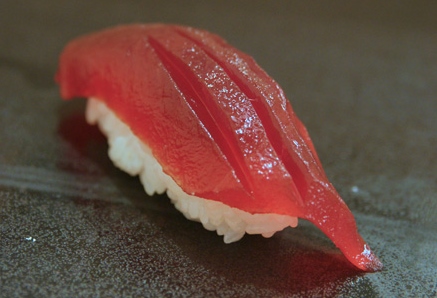 The meat of tuna gets leaner and muscular striations are fewer towards the inner center of the body. “Tenpa (天端)”, surrounding the spine, is deeper in color and tastes stronger. It features the tender texture coming from the finest meat quality. This is also called Tenmi (天身).
The meat of tuna gets leaner and muscular striations are fewer towards the inner center of the body. “Tenpa (天端)”, surrounding the spine, is deeper in color and tastes stronger. It features the tender texture coming from the finest meat quality. This is also called Tenmi (天身).
8. Hohoniku
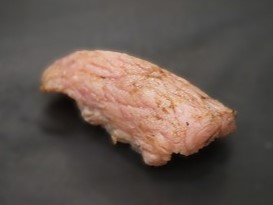
“Hohoniku (ホホ肉)” is cheek meat. The cheek meat of tuna is a rare part of the fish, with only a few hundred grams being taken from a 100kg fish. It is crescent-shaped, with one on either side. It can be taken from not only bluefin tuna, but also bigeye tuna, etc., but if you want to eat it as sashimi or nigiri sushi, you need to be careful about its freshness. Once frozen, it can only be used in dishes where the smell is masked by cooking with garlic, pepper, olive oil, etc.
Its cheek meat is juicy, stringy, and low in fat. When making nigiri sushi, it is often Aburi to soften the stringiness. Aburi enhances the flavor of this part of the fish. And there are almost no sushi restaurants that buy tuna heads or whole fish. Therefore, the only places that can offer this part of the fish are conveyor belt sushi restaurants and izakaya.
9. Hireshita
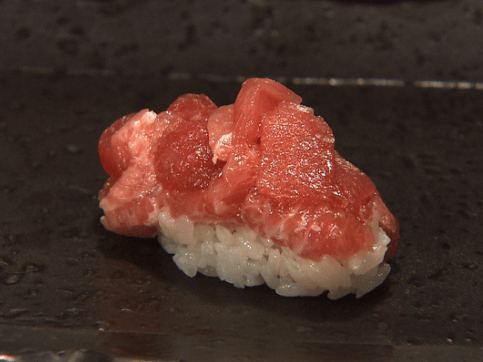 “Hireshita (ヒレ下)”-Below the “Wakaremi” is a section with white veins intertwined. This is typically used for Tekkamaki. This is because the white veins are tough and take a long time to remove. However, between the veins lies the fatty richness of Otoro and the red meat-like flavor of Chutoro, and carefully removing the veins reveals a delicious part. This truly is the valuable part of whether there will be even enough for 10 pieces of sushi from an over 200 kg tuna. This is written in a sushi manga named by Hiroshi Akiyama of Sushi Kin.
“Hireshita (ヒレ下)”-Below the “Wakaremi” is a section with white veins intertwined. This is typically used for Tekkamaki. This is because the white veins are tough and take a long time to remove. However, between the veins lies the fatty richness of Otoro and the red meat-like flavor of Chutoro, and carefully removing the veins reveals a delicious part. This truly is the valuable part of whether there will be even enough for 10 pieces of sushi from an over 200 kg tuna. This is written in a sushi manga named by Hiroshi Akiyama of Sushi Kin.
If you are fortunate enough to get an opportunity to taste these, you can take it as proof that you have been accepted as a regular and loyal customer. It is difficult to distinguish these parts by appearance alone, so make sure you try them at a sushi restaurant you can trust. Just for your reference.
Related contents: TYPES OF TUNA
We hope this information will be helpful.

Revision date: April 26, 2025
Share this article
I like the helpful info you provide in your articles. I will bookmark your weblog and check again here regularly.
Please accept my sincere apologies for this late response. We update our new blog every week. Please take a look. Thank you.